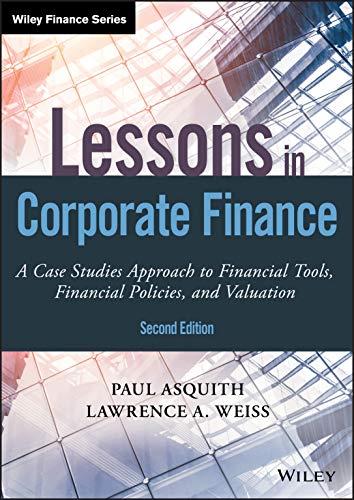Answered step by step
Verified Expert Solution
Question
1 Approved Answer
Questions 5 - 9 are about an equity - linked note. An equity - linked note is a debt instrument, usually a bond, that differs
Questions are about an equitylinked note. An equitylinked note is a debt instrument, usually a bond, that differs from a standard fixedincome security in that the final payout is based on the return of the underlying equity, which can be a single stock, a basket of stocks, or an equity index. Equitylinked notes are a type of structured products.
An equitylinked note combines two features that investors may find attractive. First, the note provides a guaranteed minimum payoff to its holder no matter how the underlying equity performs. Second, if the underlying equity appreciates in value during the life of the note, the payoff is higher than the minimum and positively related to the return of the underlying equity.
Consider a year equitylinked note whose payoff is tied to the return of the Meta Platforms Inc. Meta stock. An investor invests $ in the note today. The note expires years from today. When the note expires ie years from today the investor receives a payoff that depends on the change in the Meta stock price between today and the expiration date. For simplicity, assume that the price of the Meta stock today is $
If the Meta stock price on the expiration date is below $ the investors payoff is $ This provides the investor a form of capital protection: she will not lose money in this investment even if the Meta stock would fall in value or even if the company goes bankrupt and the stock price falls to $
If the Meta stock price on the expiration date is above $ the investors payoff is
$ x rpa x k where rpa is the relative price appreciation of the Meta stock. Formally, and simply, it is defined as
rpaPPP
where P is the price of the Meta stock on the note expiration date and P$
is the stock price today. This is simply the return of the Meta stock ignoring any dividends.
The multiplier k in the payoff function above is known as the participation rate. This rate tells how much the equitylinked note investor participates in the potential upside of the underlying equity. We dont know k yet. Your job in these questions is to figure out what k is possible.
An equitylinked note is constructed, or engineered, out of two fairly simple financial securities: a zerocoupon bond and a call option on the underlying equity.
Lets start with the zerocoupon bond. In order to provide the capital guarantee for the year note linked to the Meta stock, the issuer of the note must buy a year zero coupon bond with par value equal to $ The yield to maturity of a year zero coupon bond today is Taking into consideration that how much of the $ invested in the year note linked to the Meta stock are used to the purchase of the zerocoupon bond has to be calculateed and that: After the purchase of the zerocoupon bond, the remainder of the $invested in the note is used to purchase as many year atthemoney call options on the Meta stock as possible. This is a call option with strike price equal to the current stock price of Meta, $and expiration date coinciding with the expiration date of the note. The market price, premium, today of such call option $
Assume that the option can be bought in fractional amounts ieone can purchase, say, options
How many year atthemoney call options on the Meta stock can be purchased with the funds left over after the purchase of the zerocoupon bond?
Step by Step Solution
There are 3 Steps involved in it
Step: 1

Get Instant Access to Expert-Tailored Solutions
See step-by-step solutions with expert insights and AI powered tools for academic success
Step: 2

Step: 3

Ace Your Homework with AI
Get the answers you need in no time with our AI-driven, step-by-step assistance
Get Started


